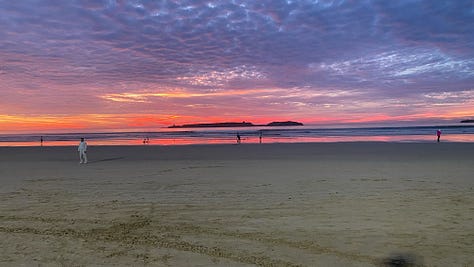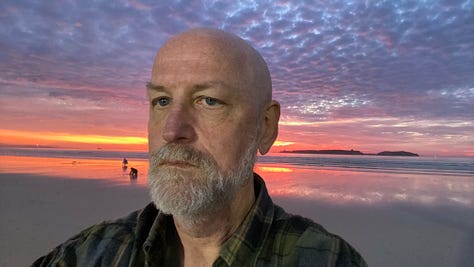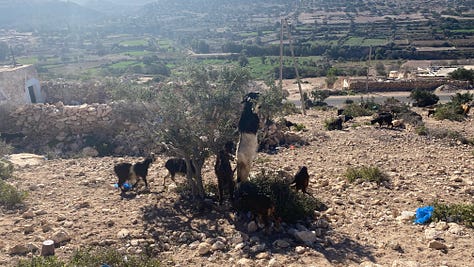Maroc ’n’ roll
Get ready to adopt a new vocabulary as we visit souks in the medina and sleep in some of the country's myriad riads
Although southern France is usually pretty warm, temperatures can dip into single digits for much of December and January, so I was Off On the Road to Morocco for six weeks this winter. Starting in Casablanca, a modern business centre where I was slated to work on a translation contract, my itinerary (and some whims) would take me to Marrakech, Essaouira, Fès and Nador, where I caught a ferry for a two-day voyage on the Mediterranean to the port of Sète for my return to France.
As I wrote last week, “Casa” isn’t exactly a hopping tourist destination. I had rented an Airbnb that was well set up for my translation work, with hi-speed wi-fi and complete privacy. I wan’t planning on doing much tourism there, I thought I’d be spending most of my two weeks in Casa working (which my visa does not allow me to do in France). But that didn’t happen, the client was late, and the work only landed as I was heading to Marrakech, where I had hoped to spend every day exploring the vibrant city and taking excursions to the desert and Atlas Mountains.
I’d even signed up to volunteer every morning with World Central Kitchen—which was feeding Moroccans left homeless by a Sept. 8 earthquake—but they had wrapped up their work and packed up for Gaza a few weeks before I got there.
Good thing for me, in the end, because my paying work would have had to take precedence. That’s why I ended up spending a lot of my time working in the central court or rooftop terrasse of my Marrakech hostel as Christmas approached unobserved. Literally.

Okay, lets get get some basic vocabulary out of the way. Many hotels, hostels and inns in Morocco are referred to as riads, which is Arabic for garden. It’s a reference to a common architectural style where the outside of the building is plain, often windowless. Inside, however, rooms are located in a ring around a large central courtyard, open to the sky. In marked contrast to the façade, the inside of a riad usually boasts vibrant colours, with garden or pool and a rooftop deck.
My Marrakech riad was in the medina, which is Arabic for city and usually refers to the historic walled village that was the heart of traditional North African communities. Many medinas were destroyed under French colonial rule, razed and replaced with European-inspired planned cities. In Morocco, however, a decision by the country’s first French résident général to preserve the central cities as heritage sites and instead build the new European cities outside the traditional core is the reason why Morocco has preserved 14 medinas in 13 cities, while in Algeria, for example, just two survived.
Inside, medinas are a maze of narrow streets, alleys, merchant stalls, restaurants, hotels, homes and busy souks. Each can host a number of different souks, an Arabic adaptation of the Aramaic word for street market. Marrakech is famous for its bustling traditional souks, hosting no fewer than 18 clustered around the central Jemaa el-Fnaa square, which just happened to be about 200 metres from my riad. Each souk is centred around a particular specialty, from expensive jewellery and crafts to leather goods, shoes, clothes and pottery, and plenty of shops selling food of every description
Marrakech
360° Video: Marrakech’s Jemaa el-Fnaa square is often very busy in evenings, especially on weekends.
As I explained in my Dec. 26 post, my translation work unfortunately took a big chunk out of my two weeks in this busy city. If I were to revisit—which I almost certainly will—I’d spend more time on excursions outside the city centre, with overnight trips to the desert (tho perhaps not in January, it can get near zero overnight) and to the Atlas Mountains.
If you go, I recommend that one of the first things you do is sign up for one of the free walking tours, which will give you a good overview of the medina over about 2 hours. It’s free, but you are expected to tip the guide at the end. Since ours was quite excellent, I didn’t mind handing him 100 dirham (about $13) at the end of the tour, which included advice on how to get rid of the many street hawkers intent on getting you into their restaurants.
Another highlight was the Jemaa el-Fnaa square, which was bursting with activities from noon to midnight that shifted with the sun, from daytime market to evening food court to nighttime music festival. Among the daytime “entertainment,” however, are captive endangered macaque monkeys, with chains around their necks, that I found appalling. Tho it is illegal to keep them as pets, an exception has been made for the Jemaa el-Fnaa monkey handlers, arguing that is represents a traditional indigenous activity. Anyway, my disgust was so obvious to one of the monkey handlers on my first visit to the square that he flashed me a special welcome to Marrakech.
Snake charmers are also still to be found on the square, to the chagrin of many and delight of the occasional ophiophilist. I just gave them a wide berth, since they sometimes approach you and offer to drape their snake around your neck. “It will cost nothing!” Perhaps, but how much do your charge to remove it?









Essaouira
Damn, I love Essaouira. It is the Goldilocks of Moroccan cities, neither too big nor to small, not too hot or too cold, too modern or too old. The medina merchants here are chill, always happy to help, but only if you ask, unlike the souk vendors in Marrakech who cajole you to buy or the next-level aggressive merchants in Fès.
And the beaches! Miles of smooth sand with a very gradual slope that makes this a very popular place for surf, kite and sailboarding schools. I started out at the super-chill Essaouira Beach Hostel, then went to a riad on the medina for a few days before opting to extend my stay with a return to the hostel.








Whether it’s the surfer influence or the California-type weather, there’s a definite hippy vibe to Essaouira, an ancient fishing port on the west coast of Morocco, about a 3-hour drive west from Marrakesh or a 4.5-hour drive south of Casablanca.









I was going to try to fit Fès and Nador into today’s post, but as the French say, sometimes I have “les yeux plus gros que le ventre,” meaning I may have bitten off more than I can chew.
Thanks for chewing with me today as I revisit my travels from earlier in this adventure and I prepare to hit the road once more at the end of April.
See you soon.









Really nice review of Morocco, Peter! Looking forward to more.